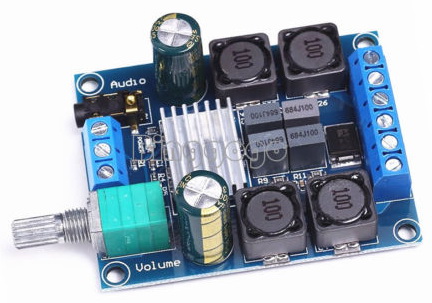Hi
You see it in most amplifier boards - 2 big capacitors:

I am curious to understand: what do they do?
Thank you
You see it in most amplifier boards - 2 big capacitors:

I am curious to understand: what do they do?
Thank you
Last edited:
They act like filters for the supply rails (positive and negative) and as energy storage. So if the amplifier needs energy immediately (such as in transients), it does not have to get it from the power supply, which can be further away.
You see it in most amplifier boards - 2 big capacitors: I am curious to understand:
what do they do?
They store charge to produce the power supply voltages, which the amp needs
to function. All amplifiers need some kind of power supply such as this.
As the capacitors are drained by the amplifier, they are recharged by the
transformer and rectifier, which source power from the AC line.
Two batteries of suitable voltage and capacity could be substituted for them,
but this is usually impractical.
Last edited:
I see, thank you very much.
There is another issue regarding speakers, that requires capacitors,
and it is the subject of DC.
Preventing DC on the speakers. (If I understand it correctly)
Does this board also have 2 capacitors to prevent DC?
Are they really small (and also SMD), so that's why we don't see them?
Or maybe this board simply doesn't have such capacitors?
There is another issue regarding speakers, that requires capacitors,
and it is the subject of DC.
Preventing DC on the speakers. (If I understand it correctly)
Does this board also have 2 capacitors to prevent DC?
Are they really small (and also SMD), so that's why we don't see them?
Or maybe this board simply doesn't have such capacitors?
There is another issue regarding speakers, that requires capacitors,
and it is the subject of DC. Preventing DC on the speakers.
Most recent solid state amplifiers are direct coupled to the speaker,
and use special feedback techniques to reduce DC output voltage to near zero.
Such amplifiers can fail, and impress DC on the speaker, unless an output relay
or fuse is used.
A proper DC blocking output coupling capacitor for an amplifier is going to be
around 10,000uF and rated at more than the amplifier's power supply voltage,
so this is a large part, if the speaker is to produce bass. This is one reason that
they are seldom used in current amplifiers.
Last edited:
Amplifiers that have dual supply (positive and negative rails) don't need DC blocking capacitors. Also, full bridge class D amplifiers also don't need those caps even though they have a single supply.
You might see DC blocking capacitors in older, single supply amplifiers. Because the audio signal swings both positively and negatively, they have to offset (or "lift") the signal so that the most negative part of it is actually at zero (or ground) potential. This is done by applying a small DC voltage. The problem is that the voltage propagates and is amplified at the output, and you need to block it from getting to the speaker. Hence, the purpose of the capacitor, which is usually a very large electrolytic.
You might see DC blocking capacitors in older, single supply amplifiers. Because the audio signal swings both positively and negatively, they have to offset (or "lift") the signal so that the most negative part of it is actually at zero (or ground) potential. This is done by applying a small DC voltage. The problem is that the voltage propagates and is amplified at the output, and you need to block it from getting to the speaker. Hence, the purpose of the capacitor, which is usually a very large electrolytic.
Last edited:
Great answers, thank you so much.
BTW,
the amplifier in the image above, is TPA3116-D2.
The amplifier here, is TDA7297:

And for some reason, it has 1 big capacitor..
Why 1 and not 2 like in most amplifier boards?
BTW,
the amplifier in the image above, is TPA3116-D2.
The amplifier here, is TDA7297:

And for some reason, it has 1 big capacitor..
Why 1 and not 2 like in most amplifier boards?
That chip uses a single rail supply. It's a good idea to look up the data sheets when you know the chips
Because it is a bridged amplifier. Esentially two amplifiers that tackle each half of the audio signal (the positive and negative) and the speaker is connected between them, so it only needs one supply rail, hence one decoupling capacitor.
- Status
- Not open for further replies.
- Home
- Amplifiers
- Class D
- What is the Purpose of the 2 Capacitors?